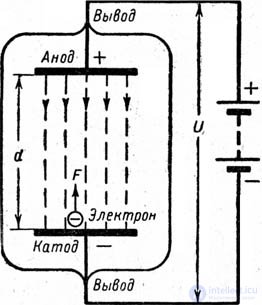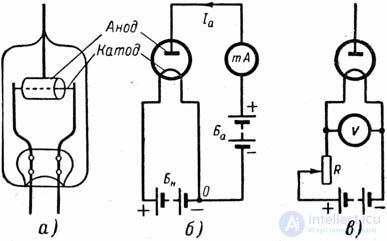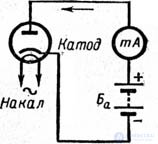Lecture
The electron, discovered at the very end of the last century, is still an object of scientific research that opens up more and more new properties. It has long been established that an electron has a negative charge e = 1.6 · 10 -19 C and a rest mass
m = 9 · 10 -28 g .
Imagine the space between two flat plates (electrodes) in an evacuated glass bottle ( Fig. 8-1 ). Recall that evacuating or creating a vacuum in a cylinder means pumping air out of it using special pumps; For the chemical absorption of gases that can be released inside the bulb of a lamp during its operation, there are absorbers (getters), such as barium, sprayed inside the bulb during the manufacture of the lamp and forming plaque on the inner surface of the glass.
 |
|
| Fig. 8-1. | Electron motion in an accelerating electric field. |
Let us imagine further that even before the balloon was pumped out, conductors were soldered to the glass and serving as terminals from the plates to the plates before they were pumped out to the plates. Outside the cylinder, one conductor is connected to the positive and to the other is the negative pole of the battery. Then the plate connected to the "plus" gets the name anode , and connected to the "minus" - the cathode .
Suppose that an electron having a negligibly small initial velocity flies out of the cathode surface. It falls under the action of the electric field, which is shown in Fig. 8-1 is depicted in the form of lines of force directed from the anode to the cathode. Electron is attracted to the anode with constant force.
Easily calculate this power. If the field between the anode and the cathode is considered uniform, then its intensity
 |
where d is the distance between the electrodes. But the electric field acts on an electron with a force equal (according to Coulomb's law) to the product of its charge and the field strength, i.e.
 |
and this force is directed towards the field. The electron will begin to move upwards, acquiring acceleration, which, in accordance with Newton's second law, is equal to the ratio of force to mass:
 |
Movement will be uniformly accelerated; consequently, as the electron moves, its velocity will increase, and with it the kinetic energy, which by the end of the path will become
 |
where v is the speed at the end of the path d .
The energy acquired by an electron when moving in an accelerating field is equal to the work that is expended by the electric field, i.e. in the end the battery. Work is calculated as the product of force on the path:
 |
Equating the energy consumed by the field to the energy acquired by the electron, we write the basic equation for the motion of an electron in an electric field:
 |
from where we find the velocity of the electron at the end of the path
 |
Knowing that the ratio of the electron charge to its mass in the conditions adopted by us is a constant value, and expressing the speed in practical units ( km / s ), we get:
 |
(8-1) |
So, if the voltage between the electrodes is U = 100 V , then the electron speed at the end of the path will be 6000 km / s , which, as we see, is much lower than the speed of light ( 300000 km / s ).
It is easy to determine the electron transit time from the cathode to the anode, knowing the distance d between them. It is known that the average speed of uniformly accelerated motion v cf = v / 2 . Therefore time
t = d / v cf. For example, if in the above case d = 1 cm (i.e. 10 -5 km ), then the span time will be t = 2d / v  2 · 10 -5 / 6 · 10 3 = 1/3 · 10 -8 s , i.e. approximately 0.003 μs . This time turned out to be equal to the radio wave period of 1 m .
2 · 10 -5 / 6 · 10 3 = 1/3 · 10 -8 s , i.e. approximately 0.003 μs . This time turned out to be equal to the radio wave period of 1 m .
So, the field, which accelerates the movement of an electron, does work that increases the kinetic energy of the electron. Upon impact on the surface of the anode, the kinetic energy of the electron is converted into thermal energy: the impacts of the electrons heat the anode.
Consider the second case of motion of an electron in the same balloon. Suppose that an electron located near the surface of the anode received a push towards the cathode. The initial electron velocity turned out to be directed towards the electric force acting on it. Then the field will not be accelerating, but inhibiting the movement of the electron; the electron will move uniformly in slow motion. The energy that an electron acquired at the time of the initial impulse will be consumed as it moves in a decelerating field: in this case, the electron gives up energy to the electric field. The following case is also possible: without reaching the cathode, the electron will expend all its energy, stop, and then begin to move back to the anode, accelerating evenly.
The third characteristic case is the push imparted to the electron in the direction transverse to the field. The motion will be non-linear: the electron will deviate from the transverse path in the direction of the anode, and the degree of deviation will depend on both the initial velocity of the electron and the electric field strength ( E = U / d ).
These are the simplest cases of interaction between an electron and an electric field. The interaction always manifests itself in a change in the electron velocity and in the energy exchange between the electron and the field created by the anode battery. In the accelerating field, the electron acquires energy from the battery, and in the decelerating field it transfers energy to the battery. If the electron moved not in a vacuum, but in a space filled with a gas, then the processes described by us would be disturbed due to collisions of the electron with the gas molecules. The interaction of the electron with the magnetic field will be discussed below.
Now imagine that electrons near the cathode appear continuously and under the action of an electric field move to the anode. Then in vacuum and in the battery circuit an electric current is established, the value of which is determined by the number of electrons reaching the anode per second. So, if about 7 · 10 12 electrons fly through the balloon in a second, then the current will be 1 μA . The direction of the current is still taken to indicate the opposite direction of motion of the electrons.
It is possible to create conditions for establishing and maintaining current in a vacuum device by selecting a cathode that has the properties of emission (expulsion) of electrons from its surface. Such a cathode can be called an "emitter" (sending electrons); the anode can also be called a "collector" (collecting electrons). However, the name "emitter" and "collector" are more often used in semiconductor devices.
In order to create a noticeable current in a vacuum, the effect on the cathode of a single voltage is insufficient, since electrons can freely exit from the metal of the cathode beyond its surface. The fact is that the atoms of the metal from which the electrons have separated, become positive ions; they attract inside the metal every electron that goes beyond the surface. Only with a sufficiently high initial velocity of departure is the electron capable of breaking away from the metal. The emission of electrons from the surface of the cathode can increase significantly if the electrons in the metal are given additional energy.
There are three practically used methods for increasing the energy of electrons in a conductor: heating, which creates thermionic emission ; irradiation of the surface of the conductor with light, creating photoelectron emission ; the bombardment of the surface of the conductor from the outside by electrons having a high speed and creating secondary electron emission . In most types of radio tubes, thermionic emission is used. The cathode is heated by electric current, like a filament in an incandescent lamp; That is why electrovacuum devices are called lamps. To heat the cathode there must be an independent current source.
Increasing the temperature of the metal increases the average energy of motion of the electrons in the whole mass of the metal, and a significant number of electrons acquire a speed sufficient to exit into the surrounding space. Pure metals give a noticeable emission only at temperatures of several thousand degrees. Such heating is maintained by refractory metals, for example, tungsten, which is widely used for cathodes of radio tubes.
As the simplest example of a radio tube (an electron vacuum device with thermionic emission), consider a diode (a lamp with two electrodes) used for rectifying alternating current, detecting and performing other functions in radio equipment.
 |
|
| Fig. 8-2. | Device and the inclusion of the diode: a is the simplest design of the diode; b - diode in the circuit; in - adjustment of heat. |
In a glass evacuated cylinder ( Fig. 8-2 , a ), two electrodes — the anode and the cathode — were strengthened. The anode is made in this example in the form of a metal cylinder located horizontally and having a lead upwards through the glass. The cylindrical shape is more convenient than flat, in the sense of cathode coverage; but other forms are possible.
The cathode in the form of a filament, passing along the axis of the cylinder, has two terminals connected to the battery filament. Electrodes of a lamp can be designated on schemes, as shown in fig. 8-2 , b .
Both cathode terminals (filaments) are connected to a self-contained radiator B n . The current of this battery passing through the filament heats it to a temperature at which sufficient electron emission is achieved. If it is necessary to set the precisely set temperature of the thread, a filament voltmeter V and a resistor R (in accordance with the scheme in Fig. 8-2 , c ) are connected to its terminals.
Between the anode and one of the clamps of the cathode an anode battery B is inserted, while observing the polarity ensuring the attraction of electrons to the anode. The anode current is measured with a milliammeter mA connected to the anode circuit; the amount of current is equal to the sum of the charges of electrons reaching the anode within a second. The anode current circuit goes from the plus anode battery B a to the anode, then from the anode to the cathode in the evacuated space, then down the cathode to the common point 0 of the batteries and to the minus of the battery B a ( Fig. 8-2 , b ). The direction of the anode current Ia is shown in the opposite direction to the movement of electrons.
If we changed the polarity of the anode battery and the anode turned out to be negative with respect to the cathode, then the electric field would not be accelerating, but it would also decelerate the movement of electrons to the anode. This makes it possible to use the diode as an AC rectifier.
Let us turn to the device cathodes. For each metal, including tungsten, at a permissible temperature, a certain (on average) number of electrons per square millimeter is emitted. Therefore, the dimensions of the cathode must be such that the required emission current is obtained from its surface. The more anode current we want to receive, the larger the cathode must have; accordingly, it is necessary to expend more power on its heating (a necessary but not useful expenditure of power).
Pure tungsten is uneconomical in this respect. It has to be heated to such a temperature (at least 2200 ° C ), at which the metal evaporates and the cathode serves for a short time (on average, up to 1000 hours ). Burnt tungsten cathodes can only be replaced in very powerful lamps, and they are used there.
To reduce the operating temperature of the cathode, while maintaining good electron emission, it is necessary to facilitate the release of electrons from the metal. To this end, the cathode is coated with a layer of another metal one atom thick. The contact potential difference of two metals partially compensates for the inhibitory effect of the surface of the base metal and contributes to the emission of electrons. Therefore, the coating of the cathode is called its activation.
Among the activating coatings, you can specify the thorium, which covers the specially treated carbon (carbidized) surface of the tungsten filament. Thoriated carbide cathodes have an operating temperature not higher than 1700 ° C (yellow heat) and are most often used in lamps for medium power radio transmitters. A lamp with such a cathode may fail, not as a result of a thread burning, but due to the destruction of the activating coating; in such cases it is said that the lamp "loses emission".
Other activating coatings can be oxides (oxides) of metals of barium or strontium, which are applied not to tungsten, but to nickel. The activating metal layer is released from the oxides during the heat treatment of the cathode. Oxide cathodes operate at about 800 ° C (cherry red heat). They have a reserve of an activating metal in oxides and therefore are less sensitive to heat and more durable ( 5000 hours or more). In addition, they are able to give an increased emission during short-term voltage inclusions (pulse operation).
However, all these cathodes of direct ( direct ) filament are almost not found in broadcasting receiving-amplifier equipment powered from an AC network. The fact is that if the direct filament is fed with alternating current, then the common point 0 (see Fig. 8-2 , b ) alternately turns out to be under positive and negative potential relative to the middle of the thread, and therefore the anode voltage changes (pulses) and low-frequency sound (background) may be generated in the receiver's loudspeaker.
Much more widely in the receiving and television equipment are used lamps with cathodes, which are powered by alternating current, but have a constant potential with respect to the anode (equipotential cathodes). In them, the filament is not intended for emission; it only heats the cathode separated from it through the insulation. Such cathodes are called heating or indirectly heated cathodes.
The sketch of the indirectly heated cathode (with a cut-out of a part of the wall) is shown in fig. 8-3 . The cathode itself is a metal tube 1, on the surface of which a layer of barium oxides 2 is deposited. Inside the tube is placed a rolled loop of the filament 3, covered with a heat-resistant layer of alundum 4 (insulating material based on aluminum oxide). Such designs of heating cathodes can also be found, in which the heater is made in the form of a flat spiral, and the cathode is a flat cylinder closed with an oxidized bottom from one end.
 |
|
| Fig. 8-3. | The device cathode indirect heat. |
In fig. 8-4 is a diagram of a diode circuit with an indirectly heated cathode, with alternating current supplying the filament circuit. Sometimes, in contrast to this pattern, the cathode is connected to one of the ends of the filament; however, the glow circuit and the anode circuit are always separated from one another, i.e. do not have a common plot. Therefore, the ac voltage does not affect the anode. At the same time, a massive heating cathode with thermal inertia ensures the constancy of its average temperature with alternating current of heat.
 |
|
| Fig. 8-4. | Inclusion of a diode with an indirectly heated cathode. |
Naturally, when the cathode is heated by a filament through insulation, the efficiency of the filament decreases. When powered by AC power supply, the issue of efficiency is not as acute as with battery-powered portable equipment. After switching on, the massive cathodes of “heating” lamps require several seconds to warm up to the normal (emission) temperature. In circuits that do not have a connection between the cathode and the filament, sometimes it is necessary to create a voltage between them; this voltage should not exceed hundreds of volts, since at large values breakdown of alund isolation may occur.
Lamps indirect heat with a well-developed production technology have a service life of 5000 hours or more.
Comments
To leave a comment
Radio tubes and ion devices
Terms: Radio tubes and ion devices